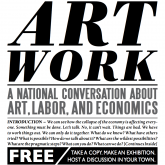Week 26: Art Work
Hi Everyone,
This Tuesday is another event in a year-long series of weekly conversations and exhibits in 2010 shedding light on examples of Plausible Artworlds.
This week we’ll be talking with Salem Collo-Julin, one of the founders of Art Work.
Artwork is “a national conversation about art, labor, and economics” — a conversation that takes the form of a website and a free, 40-page newspaper comprised of writings and images from artists, activists, writers, critics, and others on the topic of working within toady’s depressed economies and how that impacts artistic process, compensation and artistic property. Freely downloadable, the newspaper “asks us all to consider how to use this moment to do several things: to work for better compensation, to get opportunities to make art in diverse and challenging settings, and to guide art attitudes and institutions, on all levels, in more resilient directions. It is also an examination of the power that commercial practices continue to wield and the adverse effects this has had on artists, education, and our collective creative capacity.”
Art Work was conceived and produced by Temporary Services, an Illinois-based group formed in 1998, which, over the years has produced a wide variety of exhibitions, events, projects, and publications.
http://www.temporaryservices.org/
Temporary Services, along with the help of SPACES Gallery in Cleveland, have distributed over 10,000 copies of Art Work internationally since its initial publication in November 2009. Recipients of these free copies have been encouraged to create their own programming using the themes in Art Work as a starting point. Many of the events, talks, and exhibitions that have resulted are available to view at http://www.artandwork.us/category/events/
As well as looking closely at the Art Work project and the work of Temporary Services that produced it, tonight’s conversation may be a good occasion to touch on a phenomenon that appears recurrent amongst “plausible artworlds” — that is, their propensity to engender or fructify other artworlds. This would seem to raise a series of further questions: What are plausible artworlds’ mode of reproduction? What kind of “family resemblance” can be observed? Is there a lineal — or even patrilineal or matrilineal — relationship between Temporary Services and Art Work, amongst other examples? Or is the relationship not more “avuncular” — introducing a shift, like the knight’s move in chess — meaning that Art Work might better be seen as Temporary Services’s nephew?


